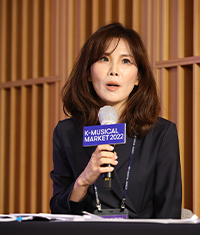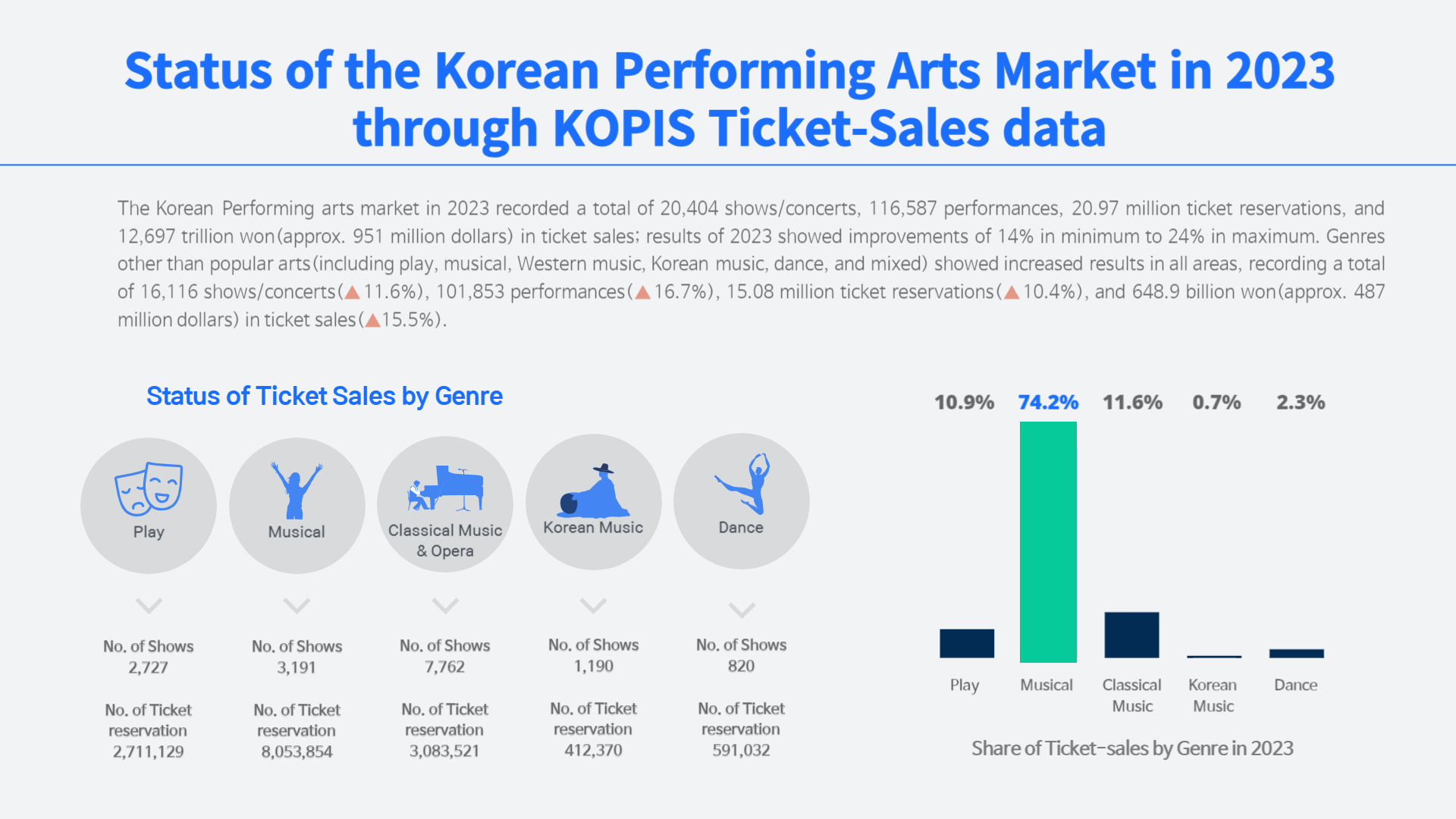What Data Tells Us about People That Shape the Market
Eunkyung Kang
The second edition of the K-Musical Market took place from June 21 to 23, 2022 at the Sejong Center for the Performing Arts. The event is designed to promote investment in the musical theater industry from home and abroad and create a reliable environment for producing musicals and bringing them to audiences. As part of the information-sharing program, the Performing Arts Data Forum was held on Day 2 under the theme, “Korean and International Musical Markets Seen from the Data Perspective” to understand the trends of the musical market based on an analysis of data from the Korea Performing Arts Box Office Information System (KOPIS) and discuss how to boost the creation and use of such data. In front of a passionate audience that filled the venue, Korean and international experts in the performing arts engaged in presentations, subject discussions, and Q&A sessions, which served as an opportunity to assess the resilience of the musical market in this new normal environment that requires a novel approach and to explore questions and tasks regarding the effective use of data to further promote the musical theater industry.
In the first half of the forum, I delivered a presentation on the pre- and post-COVID trends of Korean and international musical markets. It was meant to be a brief look at the markets before and after the outbreak of the pandemic from the perspective of publicly available data. In the case of Korea, the analysis was based on ticket sales data that spans from the launch of the KOPIS to the most recent years. In 2021, the second year of the pandemic, the performing arts market in general grew year-on-year and showed signs of recovery, The musical industry, in particular, demonstrated a faster recovery than other sectors. With respect to market sensitivity to the number of COVID-19 cases and social distancing measures, the market emerged from difficulties in the first year of the pandemic to find some sustained stability without any major disruptions in 2021. The American musical market has experienced an overall recovery, but the economic environment in the first half of 2022 alongside volatility in market indicators has the market looking for some sort of stability. In China, the supply and demand in the performing arts market have been largely controlled by the government in an effort to address a range of uncertainties for the industry that were brought on by the pandemic. As with other countries, Japan saw its musical sector fare well during the pandemic period in comparison to the entire performing arts industry, which is expected to recover from the second half of this year.
In his presentation entitled “The features of the Korean musical market from the perspective of KOPIS data,” the second presenter, Columnist Byung Sung Park, analyzed the characteristics of each sector and discussed how to ensure that different market players, who are the consumers of data, get information they need. When it comes to the musical market in Seoul, a cross-tabulation analysis of homegrown shows, licensed productions, and performances by foreign troupes and of musicals performed in small, mid-sized, and large theaters reveals that the average revenues per production were relatively high in 2021 because popular licensed shows accounted for a significant proportion of all performances staged and the average number of performances per production was high since many of them took place in large theaters. In other parts of the country, the number of productions was larger than in Seoul but the average number of performances per production was considerably lower, leading to a big gap in the total number of audience members and resulting ticket sales. The average price of tickets was higher in non-Seoul regions since a large share of shows were staged in big theaters, and the presence or lack of musicals-only theaters and year-round performances also affected audience demand. In addition, a survey of musicals performed in the Daehak-ro area demonstrates that Korean original shows far outnumbered licensed productions and a majority of homegrown and licensed performances took place in small and medium-sized theaters, respectively.
Emma Martin, a marketing consultant based in the United Kingdom, gave a thought-provoking presentation entitled “How to use the data analysis for the musical marketing and subsidy.” She introduced the case of the Society of London Theatre (SOLT) as she emphasized the importance of audience segmentation for effective marketing campaigns in connection with data use, The SOLT extends marketing support by leveraging a range of data it has collected such as the number of audience members, total ticket sales, and average ticket price, but it is difficult to apply the data to all marketing campaigns because the type of audience and pricing policy vary from production to production. In the U.K., Audience Finder offers a tool to gather and analyze data in a standardized way and present accurate audience statistics on the local and national levels. Industry stakeholders can take a look at statistics for the U.K. during the last two pandemic-hit years and leverage relevant data such as cultural behavior, spending habits, place and type of residence, and preferred media outlets in reaching out to audiences. Martin emphasized how crucial it is to take an audience-centered approach in a diversified market like the U.K. In a similar vein, she suggested the parallel use of narrowcast and broadcast as a post-COVID lesson and cautioned against ignoring the importance of tracking the results of marketing and the return on investment (ROI) or the influence of digital theaters.
In the second half of the forum, participants discussed how to leverage performing arts data and promote the use of such data. The first subject of discussion was the range of data collection to boost the musical market. Donghyun Lee, manager of the Performing Arts Consulting and Producing Team at Interpark, said that the outbreak of COVID-19 highlighted the need for data use and prompted his team to explore different options. Referring to the difficulty in determining the scope of data disclosure, he expressed his opinion that there needs to a consensus in the field in order to collect and leverage data for the sake of boosting the industry. Martin cited the case of the U.K. where demographic statistics is used in combination with data on cultural enjoyment. She mentioned the limitations in conducting production comparisons and the recent industry focus on the classification of behavior based on audience segmentation, stressing the need to categorize audiences in detail from the early stages of marketing campaigns. Seonghoon Lee, CEO of Shownote, presented his opinion on the types of data needed in the field. He said that while it is encouraging to see the KOPIS offer reliable data, ultimate market growth would be dependent upon the delivery of data that the market really wants. Citing the film industry where data on individual movies is created and offered to investors, Lee reiterated the significance of finding a common ground in the industry to collect data that allows investors to understand and access the market in a transparent manner. Columnist Byung Sung Park pointed out how different types of data are needed by different stakeholders such as producers, consumers, and researchers. He said that producers would benefit greatly from data on consumers who prefer certain shows or genres and that more detailed data by genre is needed, an example of which is the distinction of data between homegrown and licensed musicals to understand how successful the policy of promoting Korean original musicals has been.
The second subject of discussion was the reasons why the musical industry has been more resilient than other sectors as evidenced by the cumulative data collected since the start of the pandemic. Donghyun Lee mentioned that the musical market has been heavily dependent upon fandom and repeat audience members, and he attributed the fast recovery to the emergence of new audience from the millennials and Gen Z during the pandemic period and to the role of social media channels that these generations are familiar with. Seonghoon Lee said that the musical industry has been revitalized by the efforts of stakeholders such as private-sector producers and audiences to sustain the market, alongside the conversion of musicals into video formats to expand access. Byung Sung Park cited the pent-up demand for in-person performances and the inherent appeal of musicals, a popular art genre with an analogue vibe that mostly involves face-to-face interaction. Sharing the fact that productions which have recently attracted young repeat audience members have demonstrated significant resilience in the U.K as well, Martin said that the economic constraints and depressive mood of the post-COVID society have driven up the demand for performances as a pleasing experience.
The Q&A session that followed also proved the keen interest in the Korean musical market. Members of the audience asked questions about data collection methods and expressed their wishes to enjoy more musicals that represent different perspectives and values. What is encouraging is the fact that although the pandemic has not left any industry unscathed both at home and abroad, the Korean musical industry has continued to stage productions, which has been met with a corresponding demand, allowing for the sustained advancement of the sector. Amid the challenges and opportunities presented by COVID-19, the Korean musical industry has identified its potential to grow as a sustainable ecosystem as has been clearly evidenced by KOPIS data. Such data shows the intense efforts of the performing arts industry as a whole in response to the pandemic that has tested its resilience. Not only can it be leveraged for marketing purposes but also used for boosting investment in the musical market. Given that participants were unified in highlighting the importance of field consensus, the true influence of data will ultimately rely on people in the field of the performing arts industry that contribute to the creation of such data.

Eunkyung Kang
Eunkyung Kang teaches culture business management and cultural law and policy at the Graduate School of Art and Culture Business Management of Chugye University for the Arts and the Graduate School of Public Policy of Sookmyung Women’s University. She authored books such as A Study on the Relationship between Art and Culture and the Sate and Four Acts and Thirty Six Chapters of a Master Class on Performing Arts Law. As a policy expert in the field of the arts, Eunkyung served as CEO of the Seoul Philharmonic Orchestra. She is a director of the Korea Arts Management Service and her focus this year has been to communicate with the field by working with experts in different genres of the performing arts to analyze data from the KOPIS every month.
Email: artslaw.annette@gmail.com








 PREV
PREV

.jpg)
.jpg)
.jpg)
.jpg)











